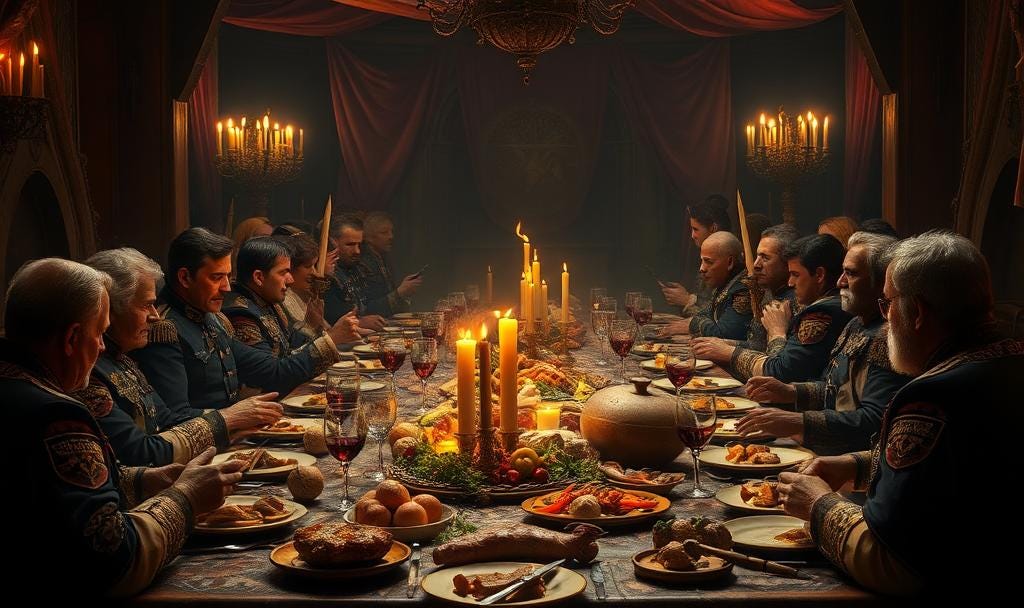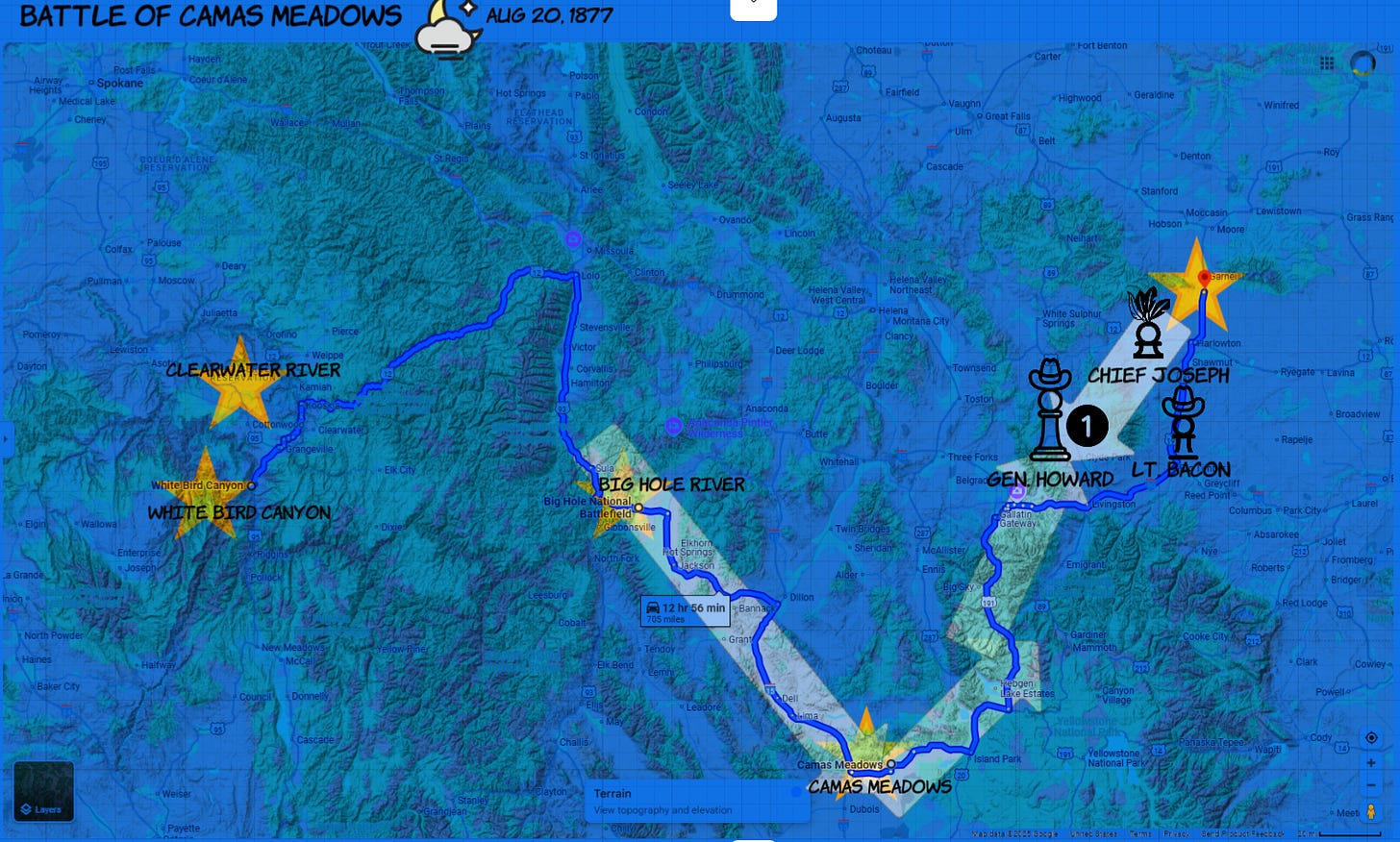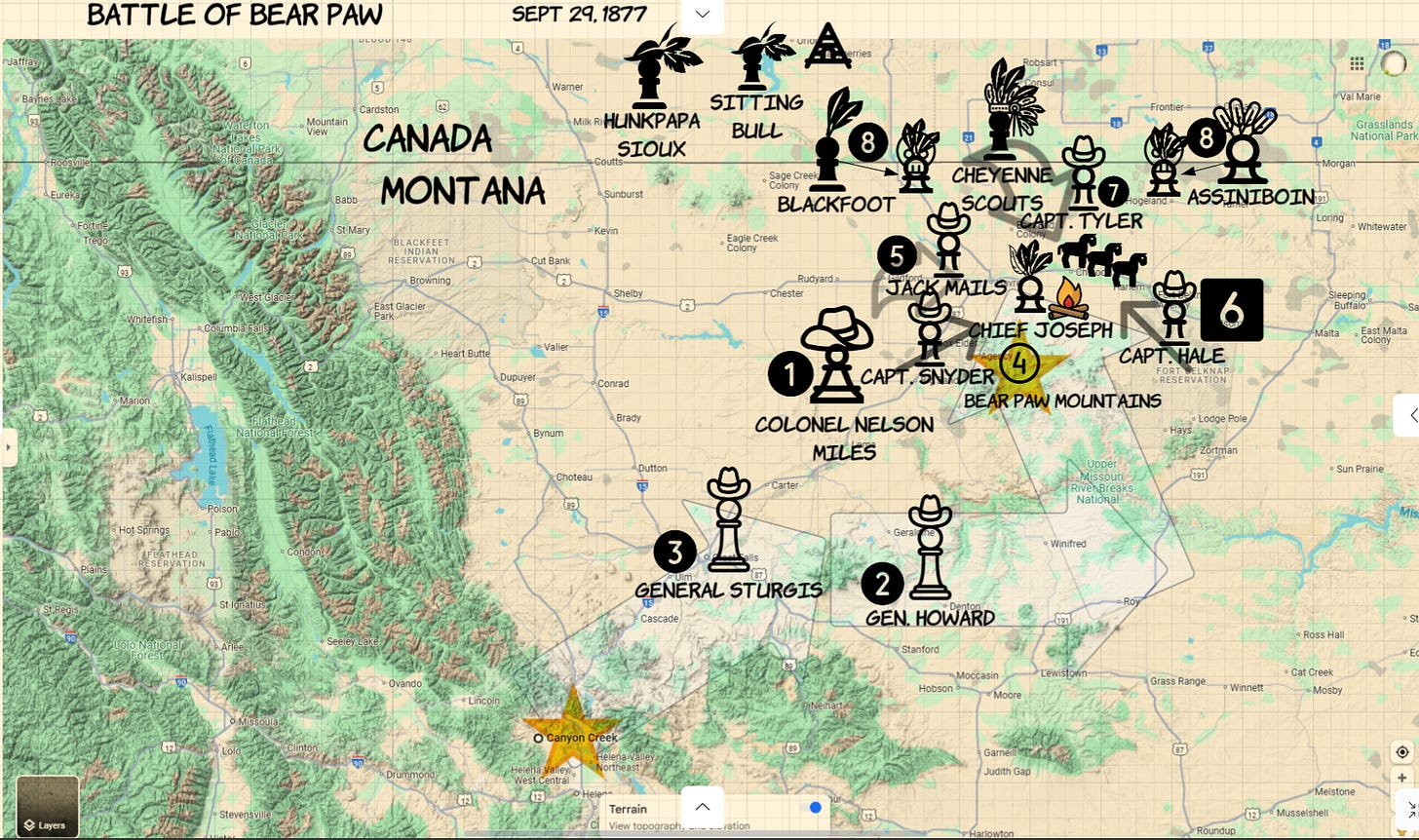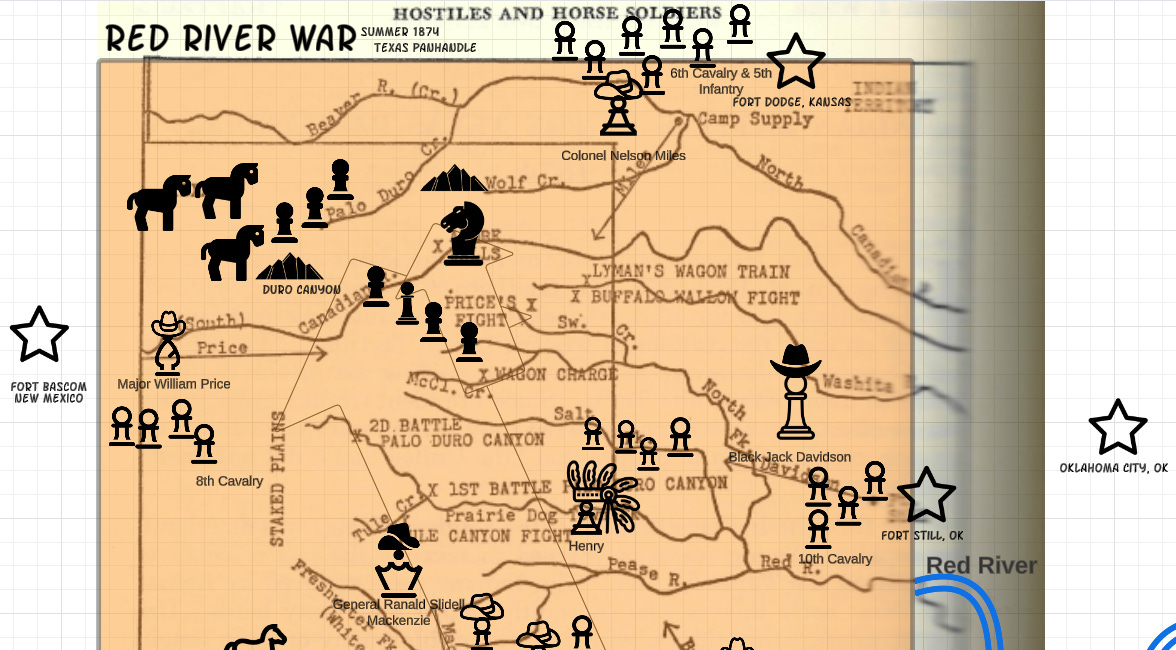Nez Perce War 1877
Chief Joseph, General Nelson Miles
When the 20 companions and their 8 guests pushed their chairs away from the dinner table and settled back to listen to General Rhode’s narrate the Nez Perces war, all felt that this country was heading for another war - in Europe. The year was 1938. Rhodes complete article was published in Proceedings.
Introduction
The Nemiipu, or Nez Perce (French for pierced noses) were a regional power in the American Northwest.
The Northwest is chronicled in https://crackpot.substack.com/t/blackfoot
Gold is discovered in Idaho in 1860.

Pressure from American settlers fractures the tribe. In 1877 an embittered Nez Perce named Tu-hull-hil-sote whose father had been killed by settlers and who had been in military prison goes on the war path.
Peacenik to War Chief
Young Chief Joseph is drawn into the war in spite of his earlier efforts to peace. Along with the Chief and Tu-hull-hil-sote the warriors White Bird, Looking Glass and Aloqat lead the Nez Perce in valor.
[1] Colonel Perry approached Chief Joseph’s Nez Perce camped in White Bird Canyon.
[2] The women and children flee across the swift flowing Salmon River with sub-chief Mox-Mox protecting the pony herd.
[3] Chief Joseph’s irregular cavalry deploy in a rough skirmish line, firing from the rocky canyon walls for cover, protected from observation and carbine and pistol fire.
[4] Chief Joseph sends Chief White Bird in a flanking maneuver around Perry’s left side.
“At the same time, Nez Perces sharpshooters pressed Perry’s right. The cavalry horses grew unmanageable, and troopers demoralized by Joseph’s enveloping movements. The fight became a rout as the white troops fled from the canyon. Riderless horses galloped haphazardly in confusion. The warriors chased the white soldiers out of the canyon all the way to Mount Ida.
Second only to Custer’s loss in the history of war, the American forces suffered 69 dead.
- General Charles D. Rhodes.
Underdog Winner
[1] General Howard crosses the Clearwater River with his entire command - 500 men of cavalry, artillery and mounted infantry. Though outnumbered, Chief Joseph does not retreat.
[2] Captain Trimble led the cavalry from the front. Joseph ordered the careful withdrawal of Indian stock into the valley. Repeated assaults by the infantry and dismounted cavalry on the Indian position established in the woods on the edge of the bluffs. Joseph and his mean repulsed each assault.
At 1 in the afternoon, Howard’s howitzer and gatling guns were put to work. But owing to the depth and nature of the canyon walls they had little effect. Chief Joseph’s position was established with three rifle pits - one facing Howard’s advance; the other two protecting their flanks. They piled loose stones to build intrenchments.
[3] Joseph detached forty warriors in a flanking maneuver.
As night came on General Howard hung on in a semi-circle formation before retreating back across the river in the morning.
300 Indians put 580 troops on the defensive. With this new victory, Chief Joseph became the War Chief of the Nez Perce.
Folk Hero
[1-3] Chief Joseph’s band make it to the Big Hole River after the battles of White Bird Canyon and Clearwater River.
[4] General Gibbon comes from Fort Shaw to find the Nez Perce, while -
[5] General Howard tracks the Nez Perce along the Lolo trail, as does -
[6] Captain Rawn was tracking the Nez Perce and joins Gibbon.
Joseph held to a moral code. He promised not to molest white settlers and farms along the Lolo valley. The inhabitants of the valley, in turn, sold Joseph much needed supplies, including guns and ammunition. Unnerved by the people’s support of Chief Joseph, Captain Rawn, was forced to give up his pursuit of Chief Joseph and join General Gibbon.
[7]
As daylight broke, the soldiers attacked the unsuspecting encampment. General Gibbon’s cavalry led the charge. Many Indians fell at once. But others grabbed their rifles and sought cover in the willows. The troops fired on fleeing men, women and children.
As the panic passed, the Nez Perces fired upon the unprotected position of Gibbon’s men with deadly accuracy.
Gibbon’s troops took possession of the Nez Perces camp. But the Indians clung tenaciously to the willows and river bluffs. Joseph led a countercharge to regain possession of the burning teepees.
The main body of Nez Perces intrenched themselves among the hills. Twice Gibbons soldiers charged the willow thickets on either side of the camp. The Nez Perces turned the soldiers back both times.
General Gibbons losses in killed and wounded were severe. Gibbons was wounded in the leg. The Civil War veteran ordered a retreat - first to the banks of the stream, then by wading to the further side, and up additional willow thickets to higher ground. Gibbons soon learned that the Nez Perces sharpshooters were outflanking his troops. As the day wore on, the tired soldiers found themselves slowly forced up the slope of the hills and all but surrounded.
Joseph set fire to grass to dislodge soldiers and mask flanking movements. Joseph’s attacked Gibbon’s wagon-train, held in the rear of American lines, including capture of a howitzer and several thousand rounds of ammunition.
- General Charles D. Rhodes.
General of Generals
“I’m tired of being trailed by the white soldiers.” - Chief Joseph
[1]
Joseph knew of Howard’s detachment of Lt. Bacon and forty or fifty cavalry sent to cut Chief Joseph off at Teacher’s Pass.
On the night of August 20 Joseph took forty or fifty mounted warriors, and with military precision in “columns of fours”, advanced to Howard’s camp. The ruse worked. The soldier sentry, seeing the Indians in columns, mistook them for Lt. Bacon’s detachment. They were late in raising the alarm. Dashing forward, the daring Indians completely stampeded Howard’s pack-train, and in driving the animals off under the cover of a furious fire.
The troops hastily mounted their horses in the dark and pursued the Nez Perces. Shortly after dawn, they recovered seventy-five mules, but fell into a trap. Joseph drew them into a line of riflemen, lying dismounted in lava beds, while enveloping lines of Indians attacked on both flanks. Howard withdrew.
Howard found himself without a pack train, crippled, unable to continue pursuit. The midnight surprise attack was a humiliating defeat for Howard. Chief Joseph and his men, impersonating his troops, entered his camp, killed his men, and escaped with all of his pack animals.
- General Charles D. Rhodes.
Escape Artist
[1]
General Howard made haste to resume pursuit of the Nez Perces and counted. Lt. Bacon failed to stop the Nez Perce. Chief Joseph crossed the Yellowstone River and entered densely wooded country.
General Howard found Baronet’s Bridge destroyed.
Meanwhile, General Sturgis with the 7th cavalry moved in to squeeze Chief Joseph between Howard. Pretending flight along the Stinking Water River, Joseph drew Sturgis and his force in hot pursuit. This done, Joseph avoided Sturgis by a forced march through dense forests and passed over the Yellowstone between the two bodies of troops. Howard joined Sturgis, and both commands halted to camp.
Joseph had escaped again. Behind him lay a straight line to Canada and safety.
Sturgis was furious. He took up fresh mounts and resumed pursuit. On September 13 he caught Joseph near Canyon Creek, Montana. Preceded by Crow scouts, Sturgis raced to meet Joseph before the canyon’s entrance. Chief Joseph had guessed General Sturgis’ purpose and had posted an advance detachment of Indian sharpshooters on the bluffs lining either side of the canyon, while Joseph and his main body redoubled efforts to reach protective cover. Joseph’s riflemen checked the 7th Cavalry, while a small mounted rear-guard detachment covered Joseph’s retreat.
Sturgis crippled Joseph in one way, - the capture of several hundred ponies.
General Rhodes.
Surrender & Exile
“Look twice at a two-faced man.” - Chief Joseph
[1] Upon hearing the news of Joseph’s escape at Fort Keogh, General Nelson Miles entered the field at once. General Miles had 383 men with him… this force began its march along the north bank of the Yellowstone in an effort to reach the Missouri River and intercept Chief Joseph before he might link up with Sitting Bull and the Sioux in Canada.
[2] General Howard sent his tired and worn troops to base from the Judith Basin.
[3] General Sturgis had stopped at the Missouri River.
[4] After a brilliant campaign, Chief Joseph made a serious error. Cold weather set in, and the hunting was good, the Nez Perces tired and wounded. The Nez Perces camped at Snake Creek on the north slope of the Bear Paws - just forty miles from Canada. General Miles scouts soon located the Nez Perces and he closed in.
[5] Miles sent scout Jack Mails to the east slopes of the Bear Paws to spy on the Nez Perces.
[6] Captain Hale, with the 7th Cavalry, charge the south end of Chief Joseph’s camp. Captain Tyler, with the 2nd Cavalry and Cheyenne scouts, go by circuitous route to stampede Joseph’s pony herd on the north end of camp.
Captain Snyder and General Miles attack the left side of Chief Joseph’s camp.
[7] The siege lasted from Sept. 29 to Oct. 4. With inches of snow on the ground, unwilling to leave the women and children to flee into Canada, Chief Joseph surrenders.
[8] The Nez Perce that surrender are put on a reservation. The Assiniboin killed one detachment of the band which escaped. The Blackfoot wiped out another group a few days later.
The Nez Perce war ends.
General Sherman wrote of the Nez Perce,
“Thus has terminated one of the most extraordinary Indian wars of which there is any record. The Indians displayed courage and skill that elicited universal praise. They abstained from scalping, let captive women go free, did not commit indiscriminate murders on peaceful families and fough with almost scientific skill, using advance and rear guards, skirmish lines and field fortifications.”
Heartbreak
Chief Joseph was distinguished by his striking facial features and his figure. Tall, straight as an arrow, he was wonderfully handsome, with lines modelled after chiseled marble.
Chief Joseph died September 21, 1904.
Related
Generals Crook, Mackenzie, Sheridan and Sherman are the big four generals of the latter half of 19th century AIndian war. The former two for their illustrious exploits in the field, the latter for their command. Nelson Miles is the fifth Beatle among these legends, so to speak. His defeat of Chief Joseph is one of his crowning achievements. Joseph was a military genius, and reading about his run of stunning victories of Civil War veteran commanders is astonishing. Not to mention that Joseph had to account for allowing a camp of women and children to escape unharmed as part of his battle strategy and movements.
We saw General Miles lead one of the 5 columns under Mackenzie’s attack on the Comanche heartland of the Texas panhandle.
Battles of Texas Panhandle 1874
Quanah Parker was a major Comanche chief during the Red River War. What an astonishing life Quanah lived. Quanah’s life a powerful demonstration of the forces of fate. Quanah was born to a respected Comanche Chief father named Peta Nocona and a daughter of a powerful family from the new landed gentry of East Texas - Cynthia Ann Parker. As unlikely as it…
Some histories credit General Howard for largely defeating the Nez Perces. Nelson Miles swoops in on an already tired, long-running band after the other generals are exhausted. The other crown jewel of Miles’ career, assuming command for the final defeat of the Apache with the surrender of Natchez and Geronimo’s band, came in succession of General Crook. Similarly, Crook defeated most of the Apache before finally falling out with General Sheridan over doubt of Crook’s failure to apprehend Geronimo after their famed meeting in 1886. To be fair, General Crook was known to allow prisoners free as soon as the fighting was over, and did not torture or massacre non-combatants. Crook seemed to be cut from the cloth of American warrior. Crook determined to give anyone who wanted a fight their fill of a fight. But beyond that it was bygones. Crook liked to fight whoever was willing. When asked what his exhausted troops would do for provisions at the end of a long campaign, as Crook suddenly decided to cut south for action on the Smoky Hill and Bozeman trials rather than east for a nearby fort to recoup, Crook replied, ‘We still have our horses.’ And subsist on horseflesh they did, such as often happened in Crook’s to the last nub field campaigns. Crook went against a lot of military rules by employing Indian warriors, but Crook didn’t care. He was a savage. So, when Sheridan questioned how Geronimo slipped through Crook’s grasp, with the idea that Crook never took prisoners of war preferring to let survivors live to fight another day when the battle ended, Crook offered his resignation. An exasperated Sheridan accepted, Nelson Miles relieved Crook of command, and was there to take in the Geronimo’s band at Skeleton Canyon, Arizona.
Miles was haunted by the broken promises he made to the Nez Perces at the negotiation of surrender but subsequently lacked the authority to keep. That may have been why the soldiers kept such careful watch later when escorting Geronimo out of the territory by train to Florida. The alert soldiers prevented a planned lynching at one train stop. Miles promised Geronimo safe passage and arranged for that much, at least.
References
The Papers of the Order of Indian Wars. The Old Army Press. Fort Collins. 1975.














